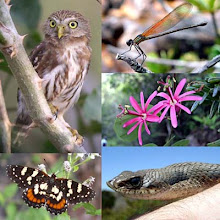Our plan for today, our last full day here, is to bird all morning along the 2 miles, arriving at the clay lick around noon. Then Carlos and Pancho will backpack our lunches in to us while we sit and watch birds coming to the clay lick. Then, after a short rest, bird our way back.
Birding was very productive along the entire trail, and there were some terrific finds. One of the best was this Slate-colored Hawk, screaming from the top of a tree.

Another was this Spotted Puffbird, which Gary noticed just before he was about to walk right underneath it. It sat there for several minutes while everyone got photos from every possible angle. This species is rather scarce, but I wonder how many go undetected as they sit so still and rarely make much sound.

Another bird highlight from this hike was a Pavonine Quetzal.
But better than any bird was this Three-striped Poison Frog, Ameerega trivittata, which I spotted perched on the end of a rotting log about a foot off the ground.
But better than any bird was this Three-striped Poison Frog, Ameerega trivittata, which I spotted perched on the end of a rotting log about a foot off the ground.

It was really shy and hopped off before I could get a good picture, but I had just gotten some recording of the calls of what I had assumed was a poison frog, and did some playback to lure it back in. It never responded, remaining with its back to me. Suddenly another frog began calling from the opposite side of the log, hopped on it and began charging me. But as soon as I moved to position my camera, he dove for cover. With much patience, I managed to coax him back again but could only manage this distant head-on shot with a flash. The first one must have been a female, and this was obviously the male.
This Three-striped Rocket Frog, Allobates trilineatus (in the same family as the poison frogs) was much more aggressive and didn’t mind my getting close.
An extensive viewing platform has been built at the mud wallow, complete with about 20 mattresses and linens, each with its own mosquito net.

Here is a track of a South American Tapir, one of the night visitors that tourists hope to see. This is the largest land animal in the American tropics, and the three species are the only extant, native New World members of the order that includes horses and rhinoceroses, Perissodactyla.

We just sat and waited quietly for birds to begin appearing (actually, I lay down and began snoring). While we waited other things attracted our attention.
Such as this Rayed Longwing, Laparus doris, enjoying the salt on my sock. It kept coming back for over an hour.

Then this gorgeous Rose-fronted Parakeet, a recent split from Painted Parakeet. There were also several Dusky-billed Parrotlets.

Lunch arrived in the backpacks of Carlos and Pancho right at 11:50 (it was a 45 minute hike for them), in the form of a delicious hot rice, vegetables and pork strip dish, cookies, juice and fruit. Not your typical box lunch.
When it was time to begin heading back to the lodge, I decided to head out on my own and take the long way back, the Trigrillo Trail. It was even swampier than the trail in, and going was slow at times. But I had a great time with the bugs, plants, and birds and frogs. I even saw another Spotted Puffbird and another Pavonine Quetzal.
Some of the butterflies:
A skipper, Two-barred Flasher, Astraptes fulgerator complex. This is the skipper that Dan Janzen and others discovered was actually 10 species in northwestern Costa Rica alone. Their caterpillars and host plants were each different, but the adults looked virtually identical, and they used DNA barcoding to confirm that each caterpillar type correlated with each DNA type in adults. Who knows how many species there are undetected in other areas of the tropics?

The rainforest is overwhelmingly green. It comes in many shades, to be sure, but it’s always a shock to see color like this jump out. It’s quite a rarity.

A Selaginella, known as spikemoss or lesser clubmoss. I’ve never seen one with such open, long branches, very fern-like. This group, along with clubmosses and quillworts, are the most ancient vascular plants. They used to be considered close to ferns, but DNA research has shown that they are very different.

Leaf-cutter ants, genus Atta. They’re a common sight in the rainforest, but this was a particularly active colony. They don’t eat the leaves but rather carry them and other plant parts to their underground nest to grow fungus.

One of the largest weevils I’ve ever seen, about 1 ¼ inches. Its defense mechanism was to tuck its snout tight up against its belly and drop to the leaflitter on its back.

Most termites either travel around at night or under the safety of a network of wood pulp tunnels that they construct. Maybe the dark bodies of this species helps protect them from sun, dessication, and predators (by looking like ants).

There were dozens and dozens of dragonflies in this swampy forest, but most were too shy to photograph easily. This is the skimmer Uracis fastigiata.

The day’s bird list ended up at 114, including five species of tinamou heard. Tinamous are ground-dwelling birds that are at first glance somewhat partridge-like. They are among the most primitive living birds and are the only flight-capable members of the superorder that includes rheas, ostiches, cassowaries, emus, and kiwis. This a recording I made of a Brazilian Tinamou, one of my favorites. It uttered this 5 ½-second, pure e-flat whistle precisely every 34 seconds for the 15 minutes that I sat there and tried to lure it in. I never did see it, and got stung by an ant in the process, but I thoroughly enjoyed the experience.












































